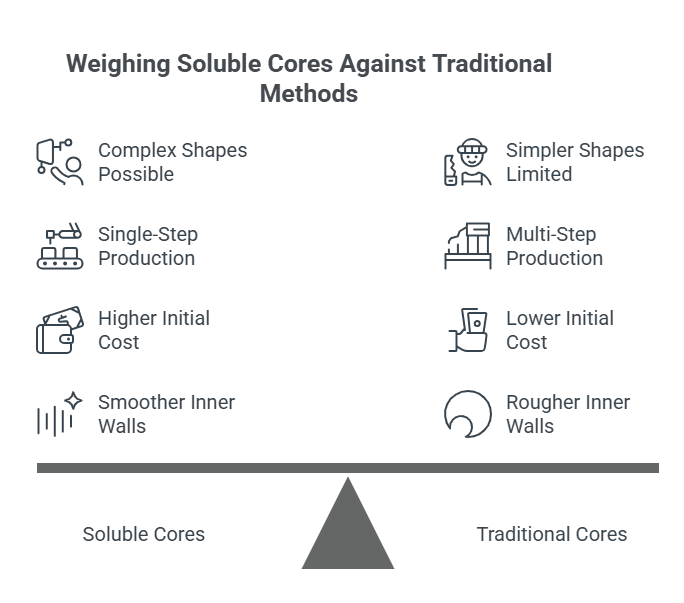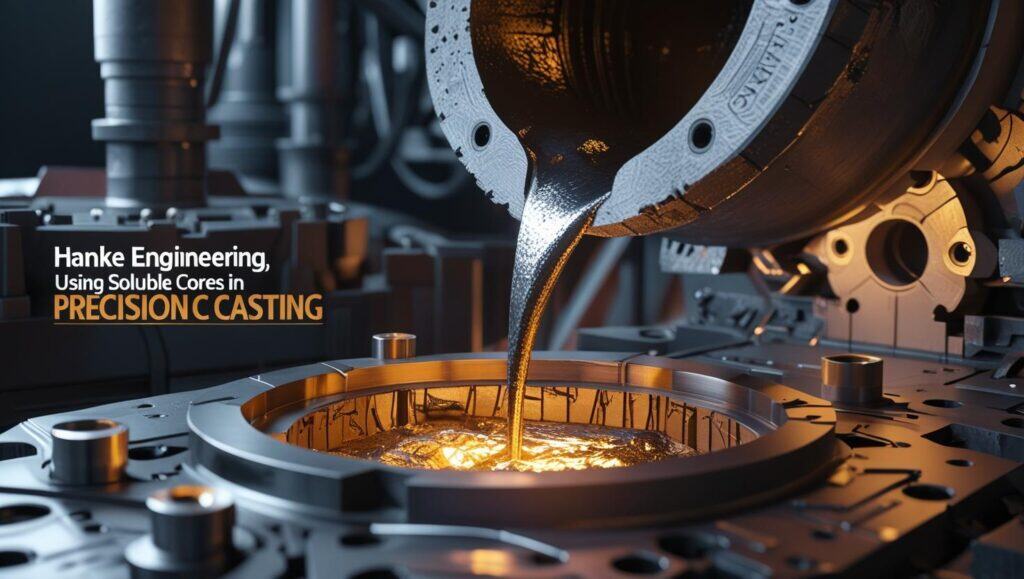Traditional cores can’t make the shapes you want inside your parts. They can’t create small or tricky spaces. Soluble cores can fix this problem.
You can use soluble cores in metal casting, injection molding, or investment casting. They help you build parts that are light and strong. You don’t need to do extra cutting or drilling.
In this guide, you will learn what soluble cores are and why they are useful. You will see how to design parts using them. You will also see how car, plane, and medical part makers use soluble cores to make better products.
What Are Soluble Cores?
Soluble cores are special parts used in casting and molding. They help you make shapes inside your part that you can’t reach with normal tools. Soluble cores are easily removable tooling used to fabricate complex composite structures, such as carbon fiber and glass fiber-reinforced polymers.
In metalcasting, cores are essential components utilized to create internal geometries and voids within cast products. The selection and performance of cores are significantly influenced by the casting technique employed, ranging from gravity casting to high pressure die casting.
These cores can be made from different materials. Some are made from salt, some from wax, and some from special sand or ceramic. People also use water-soluble cores that melt away in water.
Here is how they work:
- You put the soluble core inside your mold.
- You pour metal or plastic around it to make the part.
- When the part cools, you remove the core. Some cores wash away with water baths. Some melt with heat or dissolve in a special liquid.
For example, they help make:
- Car engine parts with inner channels
- Plane parts with lightweight hollow spaces
- Medical tools with tiny inside shapes

Why Use Soluble Cores?
Utilizing soluble cores provides many benefits, but the biggest benefit is the ability to design components with more complexity in the core of the part without costly secondary operations.
Here are some simple reasons:
- Make Complex Shapes: Soluble cores help you make parts with tiny tunnels or hollow spaces inside. You can’t do this with normal cores.
- Fewer Parts to Join: With soluble cores, you can make one strong part instead of joining many small parts. This saves time and makes the part stronger.
- Less Risk of Breaking: Normal cores can break or move during casting. Soluble cores stay in place until you remove them safely.
- Better Surface Finish: Parts made with soluble cores have smooth inner surfaces. This helps fluids or air move better inside them.
- Good Size Control: Soluble cores help keep the right shape and size inside your part. You don’t need extra cutting or drilling later.
Designing for Soluble Cores
Incorporating a soluble core into the investment casting process is achieved through strategic design and a few additional steps to our advanced investment casting process. Here is what you should know:
How Soluble Cores Are Used in Casting
First, a special soluble wax core is made by injecting wax into a small mold. This makes the core shape that will form the hollow space inside your part. The core is then cooled and taken out of its mold.
Next, an operator places the soluble core inside the main mold for your part. The core must be placed in the exact position. Small support points or pins hold it in place so it doesn’t move when wax is added later.
Then, pattern wax is injected around the soluble core. This pattern wax forms the outside shape of your part, while the soluble core forms the inside hollow shape.
When the wax cools, the whole wax part with the core inside is removed from the mold. It is placed into a bath of mild muriatic acid or water to dissolve the soluble core. This leaves behind the hollow space.
Finally, the wax part is attached to the sprue system and goes through the investment casting process. The wax is melted out, and molten metal is poured into the ceramic shell to create the final metal part with the hollow space inside.

Design Tips
- Keep Walls Thick Enough: Walls need to be thick to stay strong. If too thin, they can crack when the metal cools. For metal casting, at least 3 mm (0.12 inches) is recommended.
- Add Draft Angles: Draft angles help remove cores or patterns easily. Use 1-3 degrees to stop sticking.
- Think About Flow Paths: Design so molten metal flows smoothly around the core. Avoid sharp turns or thin gaps. Use flow simulation software to test before making molds.
- Use Support Structures: Add support pins or bridges to hold the core in place. Make sure these can be removed or dissolved with the core later.
- Choose the Right Core Shape: The core shape should match the desired hollow space. Avoid sharp corners or very thin parts. Use CAD software to model and test the core fit.
- Use CAD and CAE Tools: Use CAD software to design and check the core shape and mold fit. You can also use CAE tools to run simulations. These check how metal or plastic flows around the core and how the core holds up under heat and pressure. Simulation helps you find and fix problems before making molds.
- Check Material Compatibility: Different cores handle different temperatures: Salt cores work above 800°C (1472°F) for many metals. Wax cores melt at low temperatures, best for plastic molding. Water-soluble sand cores handle high temperatures and dissolve in water.
Design for Core Placement and Removal
Add locating features or support points to hold the core steady. Make sure there is space for water or solvent to reach the core so it can be removed later.
Plan for Shrinkage and Tolerances
All materials shrink when they cool. Adjust your core and mold sizes so the final part is the correct size.
Work with Your Tooling and Casting Team Early
Your team will help you choose:
- The best core material
- The right casting process
- The correct tolerances and supports
Applications with Complex Inner Cavities
Soluble cores help make many kinds of parts with hollow spaces inside. Here are more examples and details:
Car Engine Parts
Car makers use soluble cores to make turbocharger housings. These parts need small tunnels for air and oil. Sand casting is often used for these parts when they need strong and complex inner shapes.
They are also used for cooling channels in cylinder heads and pistons. These tiny channels keep engine parts cool and stop them from overheating. Without soluble cores, these channels would need extra drilling, which takes time and can weaken the part.
Medical Devices
Doctors use tools with tiny channels for liquids or wires. For example:
- Surgical instruments with internal water channels to cool tips during surgery.
- Catheters with long, narrow inner spaces.
- Implants with inner holes for bone growth or fluid flow.
Using soluble cores makes these parts in one step without cutting or drilling. This keeps tools clean, smooth, and safe for patient use.
Airplane Parts
Planes need ducts and pipes to guide air or fluids. These parts must be light but strong to reduce plane weight. Soluble cores help make:
- Air ducts in wings
- Fuel system parts
- Hydraulic system channels
These parts have complex shapes that normal cores can’t create. Soluble cores make the inside smooth, which helps air or fluid flow better and faster.
Automotive Cooling Systems
In electric cars, soluble cores are used to make battery cooling plates with long, narrow water channels. This keeps batteries cool during fast charging or heavy use, making them safer and last longer.
Robotic and Aerospace Components
Robots need lightweight parts with hidden holes for wires or sensors. Aerospace companies use soluble cores to make rocket engine parts with cooling channels inside. For example, the nozzle of a rocket engine has tiny tunnels to let fuel flow and keep it cool.
Better Designs with Fewer Parts
When you use soluble cores, you can make one part instead of joining many small pieces. This makes the part stronger because there are no welds or joins that can break. It also saves time in making and testing parts.
Cost and Benefits
Soluble cores can cost more to make and use at first. But you save money later because:
- You don’t need extra drilling or cutting.
- You need fewer workers for assembly.
- Your parts are stronger and last longer.
- You can make complex parts faster.
For example, some companies in the aerospace industry saved up to 30% in production time by using soluble cores instead of normal cores.
Partnering with Experts for Soluble Core Casting
Making parts with soluble cores needs good planning and the right team. You need an expert partner who knows how to design cores, choose the best materials, and cast parts without errors.
Huasuma is one company that helps with this. They are a metal casting and machining company in China. Their team makes strong parts for cars, planes, and machines. They use investment casting to build parts with complex inner cavities.
At Huasuma, engineers work with you from start to finish. They help design your part so the soluble core fits well. Their factory uses CNC machines and precision tools to create molds and cores that match your design.
They also check each part with quality tests to make sure it is strong and smooth inside. This means your parts will work better and last longer.
If you want to use soluble cores in your next project, working with companies like Huasuma can make the process easier. They have the skills and tools to turn your designs into real parts with hidden channels and hollow spaces.
Challenges and Considerations
Using soluble cores has many benefits, but there are some challenges too.
- Material Compatibility: Make sure the core material can handle high temperatures. Some metals get very hot during casting and can melt or damage the core.
- Core Stability: The core must stay strong during casting. If it moves or breaks, the part’s inside shape will be wrong.
- Removing the Core: After casting, you need to remove the core safely. Some cores wash away with water. Others need special liquids or heat to dissolve.
- Cost and Scale: Making soluble cores can cost more than using normal cores. Also, it may take longer to make each core. You need to check if it is worth the cost for your project size.
- Design Limits: Very thin or sharp shapes can be hard to make with soluble cores. You need to design the part so the core can be placed and removed easily.
Image Altg Text:
“Engineers use CAD and CAE tools to design soluble cores and check flow paths before casting.”
Future of Soluble Core Technology
Soluble core technology is getting better each year. Here are some new things coming:
- 3D-Printed Soluble Cores: Engineers are now using 3D printers to make soluble cores. This helps create complex shapes faster and with less waste.
- Eco-Friendly Materials: Companies are making soluble cores from biodegradable materials. These cores dissolve safely and do not harm the environment.
- Smarter Designs with AI: Designers use AI and computer tools to plan core shapes. This helps them find the best design quickly without many tests.
- Faster Production: New machines and materials are helping make soluble cores faster. This saves time in factories and helps deliver parts quickly.
Conclusion
Soluble cores help you make complex, strong, and light parts. They let you design shapes that normal cores can’t create. You save time because you don’t need extra cutting or joining of parts. They also give you better quality with smooth inner surfaces.
If you want to design better parts for cars, planes, or medical tools, think about using soluble cores early in your project.
Do you want to learn how soluble cores can help your next design? Contact our experts today. We will help you choose the best soluble core solutions for your parts.
FAQs
What is a soluble core in casting?
A soluble core is a special part used in casting. It makes hollow spaces inside your part. After casting, it melts or washes away to leave the empty space.
How are soluble cores removed?
Soluble cores are removed by putting the part in water, heat, or special liquids. The core dissolves or melts without harming the part.
What materials are used for soluble cores?
Soluble cores can be made from salt, wax, sand, or ceramic. Some use special biodegradable materials too.
Are soluble cores expensive?
Soluble cores can cost more at first. But they save money later by reducing extra work like cutting, drilling, or joining parts.




